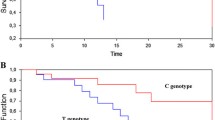Abstract
The present study analyzed the polymorphisms of DNA repair genes and their impact on the survival of 240 patients with early breast cancer. The genomic DNA was extracted from paraffin-embedded tumor-free tissue or blood, and thirteen polymorphisms in 12 DNA repair genes were determined using the Sequenom Mass array system. Among the target polymorphisms, VARS2 rs2074511 and POLE rs5744857 were found to correlate with survival after curative surgery in a log-rank test. No difference was found in the clinical and tumor characteristics according to the genotypes of these two coding variants, except for a higher incidence of positive ER in patients with the GG genotype of POLE rs5744857 (P = 0.025). Meanwhile, a multivariate analysis showed that the GG genotype of VARS2 V552 V (rs2301717) was significantly associated with disease-free survival (DFS; HR = 0.298; P = 0.044) and marginally with distant DFS (DDFS; HR = 0.266; P = 0.077). In particular, the VARS2 rs2074511 polymorphism was only associated with survival in patients with triple negative (TN)-type breast cancer (P = 0.018 for DFS and 0.042 for DDFS, respectively). In conclusion, VARS2 V552V may be considered as a prognostic factor for survival in patients with early breast cancer.

Similar content being viewed by others
References
Trojan J, et al. Functional analysis of hMLH1 variants and HNPCC-related mutations using a human expression system. Gastroenterology. 2002;122(1):211–9.
Hutter P, Couturier A, Rey-Berthod C. Two common forms of the human MLH1 gene may be associated with functional differences. J Med Genet. 2000;37(10):776–81.
Shin A, et al. Genotype-phenotype relationship between DNA repair gene genetic polymorphisms and DNA repair capacity. Asian Pac J Cancer Prev. 2008;9(3):501–5.
Goode EL, Ulrich CM, Potter JD. Polymorphisms in DNA repair genes and associations with cancer risk. Cancer Epidemiol Biomarkers Prev. 2002;11(12):1513–30.
Li J, et al. Genetic polymorphisms in the DNA repair enzyme ERCC2 and breast tumour risk in a Chinese population. J Int Med Res. 2008;36(3):479–88.
Pooley KA, et al. Common single-nucleotide polymorphisms in DNA double-strand break repair genes and breast cancer risk. Cancer Epidemiol Biomarkers Prev. 2008;17(12):3482–9.
Poplawski T, et al. Polymorphisms of the DNA mismatch repair gene HMSH2 in breast cancer occurence and progression. Breast Cancer Res Treat. 2005;94(3):199–204.
Shu XO, et al. A population-based case-control study of the Arg399Gln polymorphism in DNA repair gene XRCC1 and risk of breast cancer. Cancer Epidemiol Biomarkers Prev. 2003;12(12):1462–7.
Yuan HY, et al. FASTSNP: an always up-to-date and extendable service for SNP function analysis and prioritization. Nucleic Acids Res. 2006;34(Web Server issue):W635–41.
Rorbach J, et al. Overexpression of human mitochondrial valyl tRNA synthetase can partially restore levels of cognate mt-tRNAVal carrying the pathogenic C25U mutation. Nucleic Acids Res. 2008;36(9):3065–74.
Lee JW, et al. Editing-defective tRNA synthetase causes protein misfolding and neurodegeneration. Nature. 2006;443(7107):50–5.
Vogel CL, et al. First-line Herceptin monotherapy in metastatic breast cancer. Oncology. 2001;61(Suppl 2):37–42.
Nangle LA, Motta CM, Schimmel P. Global effects of mistranslation from an editing defect in mammalian cells. Chem Biol. 2006;13(10):1091–100.
Bacher JM, Schimmel P. An editing-defective aminoacyl-tRNA synthetase is mutagenic in aging bacteria via the SOS response. Proc Natl Acad Sci USA. 2007;104(6):1907–12.
Ropcke G, Moen CJ, Hart AA, Demant P. Effects of the MHC on hormonal induction of mammary tumors and function of hypophyseal isografts in the mouse. Immunogenetics. 1990;31(5–6):347–55.
Dux A, Demant P. MHC-controlled susceptibility to C3H-MTV-induced mouse mammary tumors is predominantly systemic rather than local. Int J Cancer. 1987;40(3):372–7.
van Kooij M, de Groot K, van Vugt H, Aten J, Snoek M. Genotype versus phenotype: conflicting results in mapping a lung tumor susceptibility locus to the G7c recombination interval in the mouse MHC class III region. Immunogenetics. 2001;53(8):656–61.
Malkki M, Gooley T, Horowitz M, Petersdorf EW. MHC class I, II, and III microsatellite marker matching and survival in unrelated donor hematopoietic cell transplantation. Tissue Antigens. 2007;69(Suppl 1):46–9.
Harney SM, et al. Fine mapping of the MHC Class III region demonstrates association of AIF1 and rheumatoid arthritis. Rheumatology (Oxford). 2008;47(12):1761–7.
Snoek M, Teuscher C, van Vugt H. Molecular analysis of the major MHC recombinational hot spot located within the G7c gene of the murine class III region that is involved in disease susceptibility. J Immunol. 1998;160(1):266–72.
Fijneman RJ, Oomen LC, Snoek M, Demant PA. A susceptibility gene for alveolar lung tumors in the mouse maps between Hsp70.3 and G7 within the H2 complex. Immunogenetics. 1995;41(2-3):106–9.
Lanning D, Lafuse WP. The mouse p52 subunit of the transcription/DNA repair factor TFIIH is located in the class III region of the H2 complex: cloning and sequence polymorphism. Immunogenetics. 1999;49(6):498–504.
Acknowledgments
This work was supported by a Korea Science and Engineering Foundation (KOSEF) grant funded by the Korean Government (MEST) (No. 2009-0091573).
Author information
Authors and Affiliations
Corresponding authors
Additional information
Ho Yong Park and Ji Young Park contributed equally to this manuscript as the corresponding authors.
Rights and permissions
About this article
Cite this article
Chae, Y.S., Lee, S.J., Moon, J.H. et al. VARS2 V552V variant as prognostic marker in patients with early breast cancer. Med Oncol 28, 1273–1280 (2011). https://doi.org/10.1007/s12032-010-9574-4
Received:
Accepted:
Published:
Issue Date:
DOI: https://doi.org/10.1007/s12032-010-9574-4



